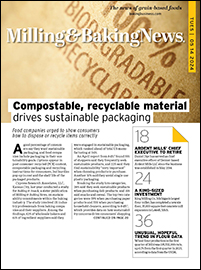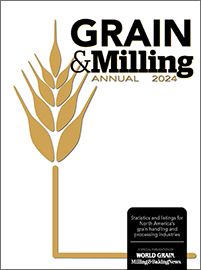BOSTON — The Whole Grains Council is celebrating the 20th anniversary of its Whole Grain Stamp this year through social media and a blog series about the launch. The stamp now is found on more than 12,000 products in 65 countries, with 342 companies participating.
The Boston-based non-profit Oldways formed the Whole Grains Council in 2003.
“The Whole Grain Stamp is successful because it fills a need,” said Kelly LeBlanc, vice president of nutrition programming at Oldways. “Consumers were falling short on whole grain intake and couldn’t easily identify them at the store. Two breads might both look alike with a brown color, but it wasn’t clear how much whole grain, if any, was in either one.
“So in 2003, Oldways organized the first meeting of the Whole Grains Council and began working toward creating a packaging symbol, the Whole Grain Stamp, which was formally launched in 2005. This same year was also when the Dietary Guidelines for Americans first explicitly recommended making at least half your grains whole.”
The stamp originally came in three varieties: “good source” if it contained at least 8 grams of whole grain per serving, “excellent source” if it contained at least 16 grams of whole grain per serving, and “100%/excellent” if all the grain was whole grain and it contained at least 16 grams of whole grains per serving. The Whole Grains Council in 2006 introduced a new design that declared the whole grain content of the food, replacing the former wording of “good source” or “excellent source.”
The Whole Grain Stamp by the end of 2008 appeared on over 2,000 products globally, and by the end of 2011, it appeared on over 5,000 products in 22 countries. The stamp could enter more countries in the years ahead, LeBlanc said.
“In Latin America and Asia in particular, we see growing enthusiasm for whole grains and may see stamped products entering other countries in these markets,” she said. “We traveled to South Africa to speak about whole grain labeling in 2023 and may also see the Whole Grain Stamp used there and in other African countries in the future.”
A survey of 1,500 US adults issued in 2023 by the Whole Grains Council found 77% said they thought they should choose whole grains more often. Seventy-nine percent said they wished information about the whole grain content of products was included on product packaging.
Today there are three different varieties of the Whole Grain Stamp. If a product bears the 100% stamp, all its grain ingredients are whole grain and it has a minimum of 16 grams of whole grains. If a product bears the 50%+ stamp, at least half its grains are whole grain and it has a minimum of 8 grams of whole grain. If a product bears the basic stamp, it contains at least 8 grams of whole grain. Each stamp also shows how many grams of whole grain ingredients are in a serving of the product.
“Currently, the vast majority (79%) of stamped products bear the 100% or 50%+ stamp, indicating that more than half of the grains are whole,” LeBlanc said. “As dietary guidance continues to emphasize the importance of making the switch to whole grains, we expect to see more manufacturers developing products in which more and more of the grains are whole.”





